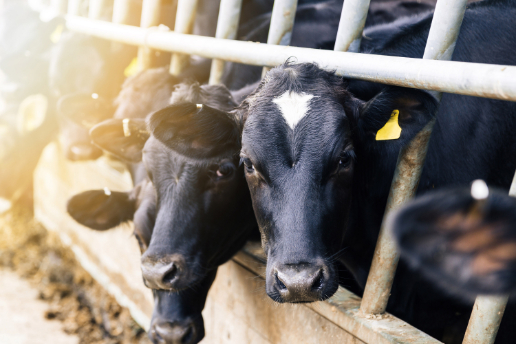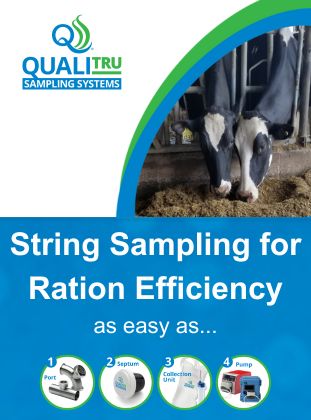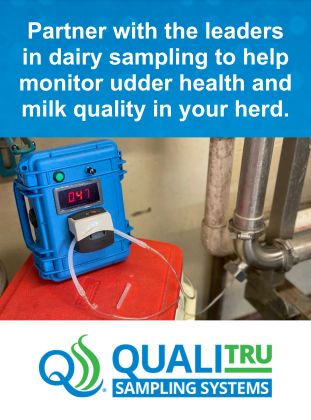Effect of maternal bovine appeasing substance on health and performance of pre-weaned dairy calves

Article and photos courtesy of Fera Diagnostics and Biologicals.
Abstract
This study aimed to evaluate the impacts of a maternal bo- vine appeasing substance (MBAS) administered to preweaned Holstein calves on their health and performance. In total, 410 calves individually allocated were enrolled (Treatment, n = 205; Control, n = 205). Treated calves received a topical application of MBAS to the nuchal skin (2.5 ml) and the skin above the muzzle (2.5 ml) at one day of age and then every 14 days until weaning at 60 days of life. An extra dose was ap- plied when calves were moved from hutches to collective pens at approximately 100 days of age. Calves allocated to the control group did not receive any kind of treatment. MBAS re- duced the incidence of diarrhea (treatment = 58.6% vs control = 70.8%; P = 0.01) as well as mortality risk (treatment = 2.4% vs control = 7.8%; P = 0.02). Furthermore, calves treated with MBAS had greater (P = 0.002) body weight 7 days after calves were moved from the hutches to the collective pens. Therefore, the use of MBAS during the preweaning period appears to be an effective strategy to improve health and growth of dairy calves.
Key words: appeasing pheromone, stress, calves, Holstein, diarrhea, weight gain
Introduction
Mammalian pheromones control innate social behavior and acutely regulate hormone concentrations. Pheromones are compounds secreted by one animal that have an effect on the physiology or behavior of another animal of the same spe- cies.1 Sensory systems that mediate touch, vision, taste, hear- ing and smell activate neural circuits in the brain. Olfactory circuits that process pheromones are highly efficient, targeting brain regions of the limbic system that coordinate behav- ioral and endocrine responses in relatively few synapses.1
Among the several different pheromones that are produced by cattle, the appeasing pheromones play an important role in mitigating stress which can cause deleterious effects either in beef or dairy cattle. There are several events that can cause undesired stress to the animals within bovine production sys- tems, such as weaning, vaccination, transport and exposure to a new environment.2,3 Therefore, exposure to stressors associated to cattle management is inevitable and strategies to alleviate the stress-induced responses are needed.4 The use of appeasing pheromone is considered an important strategy to enhance cattle welfare and productivity in the face of stressful procedures.
In the literature, the pheromone in question is described as maternal bovine appeasing substance (MBAS), and it has been reported in several studies that its topical application improved performance and reduced morbidity in beef cattle systems due to stress mitigation.5,6 However, published data showing the effects of MBAS in dairy calf-raising facilities are scarce. Therefore, the present study aimed to evaluate the ef- fect of MBAS on the incidence of diarrhea, mortality and per- formance of preweaned newborn Holstein heifers.
Materials and methods
The study was conducted in a commercial dairy farm located in upstate New York, milking approximately 5,000 dairy cows thrice daily. Immediately after parturition, calves were sepa- rated from their mothers and placed into a newborn pen bed- ded with dry wood shavings and heated with heating lamps during months with cold temperatures. All calves were fed approximately 4 L of pasteurized pooled colostrum within 5 hours of birth by an esophageal feeder (Oral Calf Feeder Bag with Probe, Jorvet). Once a day, calves were removed from the newborn pen, transported to the calf raising facilities and placed in individual calf hutches. The hutches were dis- tributed in 5 lanes containing 160 hutches each. Calves were fed milk twice daily and after the first week of life, solid feed began to be offered. The weaning process started at 50 days of calf age by reducing the amount of milk offered until the com- plete absence of milk at 60 days of age. After weaning, calves were maintained in the hutches for approximately 40 days and then moved to collective pens comingling 40 calves per pen.
In total, 410 female Holstein dairy calves were randomly en- rolled in one of the 2 treatment groups (Treatment, n = 205; Control, n = 205). The treatment allocation was performed following a sequential randomization where every other calf received MBAS (FerAppease®, Fera D&B, College Station, TX) while the other calves did not receive any application. Calves of the treatment group received a single dose containing 5 mL of MBAS on their first day of life as soon as they were allocated to the calf hutches and then every 14 days until weaning at 60 days of age. Treatments were topically applied to the nuchal skin (2.5 mL) and the skin above the muzzle (2.5 mL) as label recommended. An additional treatment dose was administered 1 day before the calves were moved from the hutches to the collective pens when they were approximately 100 days old, accounting for a total of 6 treatment administrations dur- ing the study period. Calves allocated in the control group did not receive any kind of treatment. All enrolled calves were evaluated regarding their general health focusing on detec- tion of diarrhea and respiratory diseases on a daily basis by farm personnel for a follow-up period of approximately 100 days. Calves diagnosed with diarrhea were included in the data analysis once as a diarrheic calf independently of the number of cases. Body weights were measured for a randomly selected subset of calves (Treatment, n = 39; Control, n = 39) 7 days after they were moved from individual hutches to the collective pens using a portable scale (Waypig® Digital Scale, Vittetoe Inc., Keota, IA).
Descriptive statistical analyses were performed in JMP Pro 13 (SAS Institute Inc., Cary, NC) using the ANOVA and chi-square functions for continuous and categorical data, respectively.
Differences between control and treatment calves were evalu- ated regarding serum total protein at the second day of life, proportion of calves that needed assisted parturition, and proportion of calves born to multiparous and primiparous cows. To analyze the effect of treatment on the binary response variables of incidence of diarrhea and mortality risk, logistic regression was performed using the GLIMMIX procedure of SAS. Dunnett’s significance test for multiple comparisons was used. For analyses of continuous variable responses (body weight), a general mixed linear model was performed with the MIXED procedure of SAS. Normality of residuals was assessed using residual plots. Several covariance structures were performed (autoregressive 1, compound symmetry, unstructured), and the model with the smaller AIC value was chosen. For all models, Dunnett’s significance test for multiple com- parison was used. Data are reported as LSM ± SEM unless otherwise stated. For all models cited above, the independent variables offered were treatment, serum total protein at the first day of life, dam parity (primiparous or multiparous), parturition difficulty (assisted or unassisted). In addition, two- way interaction terms between independent variables were offered to the models, with treatment being the only variable forced into the models. All the final models were built using a backward stepwise selection; independent variables and their two-way interaction terms with a P value > 0.1 were removed from the models. Significances were considered when P ≤ 0.05, and tendency was defined as 0.05 < P ≤ 0.10.
 Results
Results
Descriptive data regarding serum total protein at the first day of life, calves that had an assisted parturition, and calves that were born from multiparous and primiparous cows are pre- sented in Table 1. No differences between treatment groups were observed regarding the descriptive data analyzed. The administration of MBAS significantly reduced the incidence of diarrhea (P = 0.011) during the first 100 days of calf life, which was diagnosed in 70.8% (n = 145) of calves assigned to the con- trol group and in 58.6% (n = 120) of calves in the treatment group (Figure 1-A). Furthermore, the administration of MBAS also reduced the mortality risk during the first 100 days of calves’ life in the present study. Mortality risk was statistically greater (P = 0.02) for the control group (7.8%, n = 16) compared to the treatment group (2.4%, n = 5; Figure 1-B).
Calves treated with MBAS were 4.3 kg (9.4 lbs) heavier (P = 0.002) than control calves 7 days after they were moved from the individual hutches to the collective pens (Figure 1-C).
Discussion
Although the literature contains very few studies using MBAS in dairy calves, a similar study was conducted in Holstein x Gir preweaned female calves in which the authors also ap- plied MBAS every 14 days to the calves.7 Unlike our study, they did not observe a difference in the incidence of diarrhea be- tween treated and control calves; however, among the calves affected with diarrhea, the ones treated with MBAS had better performance in average daily gain (ADG) compared to control calves, indicating a faster recovery from the disease and lower severity of the cases.
Our study and that by Angeli et al. (2020) are the only stud- ies to have reported mortality risk in preweaned dairy calves treated with MBAS.7 In their study, no differences were found in mortality between treated and control calves; however, their mortality risk was 3.6%, which was much lower than that in our study. This indicates that MBAS could potentially have an effect in reducing mortality in highly challenged sys- tems, as observed in our study.
 In the present study, greater body weights were observed in the treated calves 7 days after they were moved from the indi- vidual hutches to the collective pens. Birth weights were not measured in this study; therefore, it wasn’t possible to calculate ADG values for those calves. However, improvement in ADG has been reported previously in calves receiving MBAS. Another study revealed that both ADG and total feed intake were increased in beef calves receiving MBAS at weaning compared to control calves.8 These authors suggested that ad- ditional administration of MBAS, such as every 14 days as in the present study, would further extend its benefits on calf growth, not only because of the increase in the feed intake, but also because of the increase in feed efficiency. Similarly, the authors also indicated that MBAS administration at 14-day intervals improved performance of preweaning dairy calves.7 Corroborating these results, positive effects of MBAS have also been demonstrated in Angus-influenced steers (n = 342) at feedlot entry, after a change in environment (animals from 16 different sources) and transportation for 12 hours.6 Feed efficiency of those animals was greater in the MBAS group compared to the control (171 vs. 142 g/kg, SEM = 10). Overall, MBAS administration to steers upon feedlot arrival enhanced body weight gain during a 45 d period by improving feed ef- ficiency.6 Other studies have demonstrated improvements of performance of feedlot cattle when MBAS is administrated to animals prior to stressful events, such as weaning and transportation.5,9,10
In the present study, greater body weights were observed in the treated calves 7 days after they were moved from the indi- vidual hutches to the collective pens. Birth weights were not measured in this study; therefore, it wasn’t possible to calculate ADG values for those calves. However, improvement in ADG has been reported previously in calves receiving MBAS. Another study revealed that both ADG and total feed intake were increased in beef calves receiving MBAS at weaning compared to control calves.8 These authors suggested that ad- ditional administration of MBAS, such as every 14 days as in the present study, would further extend its benefits on calf growth, not only because of the increase in the feed intake, but also because of the increase in feed efficiency. Similarly, the authors also indicated that MBAS administration at 14-day intervals improved performance of preweaning dairy calves.7 Corroborating these results, positive effects of MBAS have also been demonstrated in Angus-influenced steers (n = 342) at feedlot entry, after a change in environment (animals from 16 different sources) and transportation for 12 hours.6 Feed efficiency of those animals was greater in the MBAS group compared to the control (171 vs. 142 g/kg, SEM = 10). Overall, MBAS administration to steers upon feedlot arrival enhanced body weight gain during a 45 d period by improving feed ef- ficiency.6 Other studies have demonstrated improvements of performance of feedlot cattle when MBAS is administrated to animals prior to stressful events, such as weaning and transportation.5,9,10
In this study, one important limitation was the fact that calf birth weights were not measured in the farm. Therefore, the ADGs were not able to be calculated. Another important limitation in the study, was the low incidence of respiratory diseases that farm has in their calf facilities, which was lower than 3%. With that, conclusions on those type of diseases were not able to be drawn.
Conclusions
This present study reveals the beneficial effects of administra- tion of MBAS every 14 days in preweaned Holstein calves. Reduction in the incidence of diarrhea as well as mortality risk were observed in calves that received MBAS. Therefore, the use of MBAS during the preweaning period can be a suitable strategy to improve health and performance of dairy calves.
Conflict of interest statement
The authors Eduardo Colombo and Reinaldo F. Cooke have not stated any conflict of interest. However, the authors Leonardo Bringhenti and Marjory X. Rodrigues were full time employees of Fera Diagnostics and Biologicals, which is the manufacturer of the product evaluated in this study.
References
Liberles, SD, Mammalian pheromones. Ann Rev Physiol, 2014. 76: p. 151-175.
Arthington, J, et al., Effect of transportation and commin- gling on the acute-phase protein response, growth, and feed intake of newly weaned beef calves. J Anim Sci, 2003. 81(5): p. 1120-1125.
Jasper, J, M Budzynska, and DM Weary, Weaning distress in dairy calves: Acute behavioural responses by limit-fed calves. Appl Anim Behav Sci, 2008. 110(1-2): p. 136-143.
Cooke, R, Nutritional and management considerations for beef cattle experiencing stress-induced inflammation. Prof Anim Sci, 2017. 33(1): p. 1-11.
Cappellozza, B, J Bastos, and R Cooke, Administration of an appeasing substance to Bos indicus-influenced beef cattle im- proves performance after weaning and carcass pH. Livest Sci, 2020. 238: p. 104067.
Colombo, EA, et al., Administering an appeasing substance to optimize performance and health responses in feedlot re- ceiving cattle. J Anim Sci, 2020. 98(11): p. skaa339.
Angeli, B, et al., Administering an appeasing substance to Gir × Holstein female dairy calves on pre-weaning performance and disease incidence. Animal, 2020. 10(11): p. 1961.
Schubach, KM, et al., Administering an appeasing sub- stance to beef calves at weaning to optimize productive and health responses during a 42-d preconditioning program. J Anim Sci, 2020. 98(9): p. skaa269.
Cooke, R, et al., Administering an appeasing substance to Bos indicus-influenced beef cattle at weaning and feedlot en- try. Animal, 2020. 14(3): p. 566-569.
Fonseca, VG, et al., Strategic administration of an appeas- ing substance to improve performance and physiological re- sponses of Bos indicus feedlot cattle. J Anim Sci, 2021. 99(11): p. skab322.
*Leonardo Bringhenti,1 DVM, PhD; Eduardo Colombo,2 DVM, PhD (Candidate); Marjory X. Rodrigues,1 PhD;
Reinaldo F. Cooke, 2 DVM, PhD
1Fera Diagnostics and Biologicals, College Station, TX
2Department of Animal Science, Texas A&M University, College Station, TX 77843
*Corresponding author: Dr. Leonardo Bringhenti, leonardo@feraah.com



